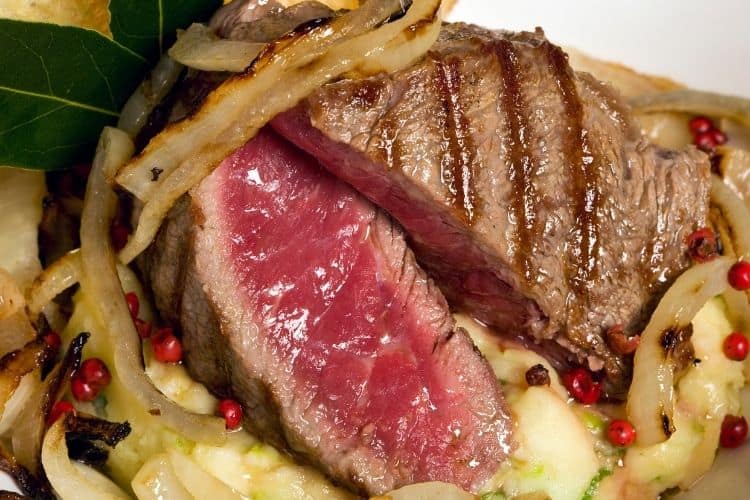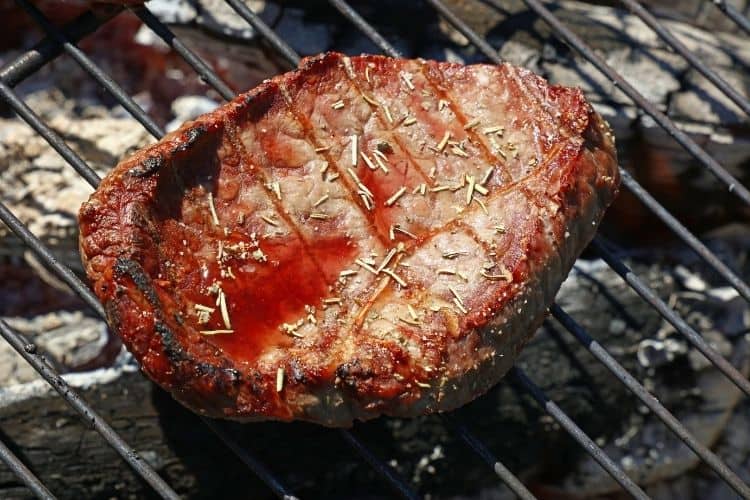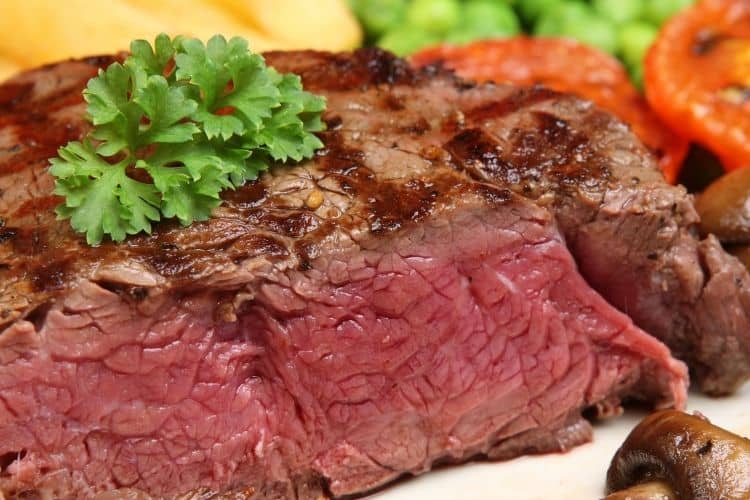- Where to Buy Whole Brisket Online - July 25, 2022
- Skirt Steak vs Flank Steak – Big Differences? - April 6, 2022
- Strip Steak Vs Ribeye: Which is Better for Date Night? - April 2, 2022
If you are a carnivorous foodie, the smell of a steak on the grill or even the thought of a steak on the grill can make your salivary glands water to a near ravenous drool. Perhaps it is the combination of fire and the smell of food roasting that awakens a distant primal desire. One thing that remains consistently true is that grilling is one of the best ways to cook and flavor a steak.
Typically, there are 5 levels of steak “doneness”. They are: Rare – Seared on the outside with about 75% pink on the inside (125F), Medium Rare – Seared on the outside with about 50 % pink on the inside (130F), Medium – Seared on the outside with about 25% pink inside (140F), Medium Well – Nearly cooked throughout with only a hint of pink (150F), and Well Done – Brown throughout, no pink at all (160F)
The “perfect steak” according to most professional chefs is between rare and medium-rare (125F -139F) This is the point at which the fat in the meat melts and the juices of the steak can move throughout the muscle fibers.
This temperature range produces the most tender and juicy steak. Less than “rare” results in a more gamey flavor and tough meat. Cooking to the level of “well-done” also contributes to a tough steak that is devoid of juiciness. Many “well done” steak lovers are also the ones with a bottle of steak sauce next to the plate. This makes up for the dryness.
There is one more level of “doneness” and that is “rarely” on any menu and that is Blue-Rare. This is the lowest level of “cooked” I put that in parenthesis because it can hardly be considered cooked.
This is like the “sushi” of red meat. A blue-rare steak is fast seared on the outside for about 60 seconds on each side leaving the inside almost 99 percent red and gel-like. That first cut into a blue rare steak reveals a blue-purple color, hence the name. As air reached the inner layer it changes from blue to red.
Some restaurants will accommodate such a request (namely in France) but don’t recommend it because it makes for a very tough and chewy steak. At this low temperature, the fats do not melt and the juices in the steak are not flowing freely.
Still, some hardcore carnivores believe this keeps the nutrients from being cooked out of the beef and prefer that gamely flavor and tough meet. Perhaps for some, it just about looking and feeling tough. Who are we to judge? If you would like to try grilling your first blue rare steak we are going to tell you just what you need to know.
Safety First!

To be clear this article is about cooking steak only. Other undercooked meats can be very dangerous to consume especially pork and some fish. Unless you have great confidence in your butcher and his/her beef source, even hamburgers should be at least medium-rare or higher.
Research has shown that bacteria and microbes such as E. coli (the microbe most known for food poisoning) are limited to the exterior of a steak. So a steak that has been seared, sealing the entire exterior of the steak, is considered safe from most germs, bacteria, and microbes. It remains essential that you sterilize your cooking utensils between each time handle a raw steak. I will cover this in the steps ahead.
Preparations for Your Blue Rare Grilled Steak
Meat Cuts
Your cut of steak remains your choice. I would recommend that you go for the lean cuts, consider top round or sirloin tip. These cuts should be about 1in thick. Remove as much fat around the edges as you can. This fat is delicious for Medium Rare and higher levels of doneness, but it does not do much for flavoring in a blue rare steak.
Seasoning
Pat it as dry as you can with a paper towel. You want the outside to sear not steam. With your meat good and dry, you can add your olive oil and seasonings of choice. Marinating is another option and can help you have a more tender blue rare experience. Just remember after you pull it from the marinade you need to pat it dry with a paper towel.
Your marinade will have soaked it if you gave it enough time. You can put a light coat of olive oil on after you pat dry your marinated steak. Allow your meat to come up to room temperature before grilling.
Preheat Your Grill
A charcoal or gas grill is fine. The key to getting any steak perfect is a HOT grill, aim for 400 – 500 degrees Fahrenheit. This blue rare cooking time is going to be VERY quick so you have to have that grill good and hot before you start to get that ideal sear.
Ready, Set, Go! You Have Roughly Less Than 3 Minutes!

You may want a few tongs or be prepared to use a food-safe sterilizing wipe on your tongs between each handling of the meat. Place the meat on the grill if you hear that hot sizzzzzzzzle right away you have a nice hot grill. Good job. Now resist any urge to move it. Let it sear for a full 60 seconds.
Then, with clean tongs flip it for another 60 seconds. Finally, with clean tongs grab it from the grill and just quickly be sure that all the sides of the steak get a good sear too. You want to be sure all the edges are seared and sealed. This will take less than a minute as the sides will already be partially seared from cooking the first two sides.
If you stayed under 3 minutes, with all sides seared, you probably nailed it but if you want to check you can insert a clean meat thermometer into the center and look for 115F -119F. If you nailed it, great.
Quickly reseal that thermometer hole with a momentary touch down on the grill and let it rest on a clean plate. Blue rare does not mobilize juices the way a rare to medium-well steak does but allowing it to “rest” for about 10 min is still recommended protocol.
A quick Reheat is Optional
You may be thinking, my already “not hot” steak will be cold after a 10-minute rest. Yes, you are right about that. Some just prefer this temperature but if you want to put a little heat back into the outer edges, go ahead and return it to the grill just long enough to sizzle on all sides for less than 60 seconds total.
This adds some nice warmth to the outer edges of your already seared steak without disrupting the magic of the rest period. It will still be blue rare just below the surface. Enjoy your steak!
The Magic 119 Degrees Fahrenheit
According to the “raw foods” movement, anything cooked over 119 degrees F destroys nutrients, enzymes, vitamins, and some minerals. Most people in the “raw food movement” do not consume meat products but for those that do, blue rare is the limit to a good steak that preserves the healthy enzymes that help you to digest meat more efficiently.
First or Last on the Grill?
If you are grilling for several people of various steak doneness it comes down to two things. The size of your grill and whether you are all planning to eat at the same time in a formal setting or is it, cook and serve on request. I like the serve-as-you-go option the best as the timing is a bit more flexible.
However, if you are all wanting to sit down to eat together, a large grill, with enough space to place all your cuts, is ideal. You will start with the ones to be well-done on the grill first, then your medium-well steaks a few minutes later. Continue to lay the steaks on the grill every few minutes that will be your Medium, Medium-Rare, Rare, and finally your Blue-Rare steaks.
This level of timing takes some practice but when you get it right, all of your steaks will be ready about the same time. Remember to clean your tongs with each flip of your “blue-rare” and not to touch any other steaks with those tongs. This gets everyone a warm meal at the same time.
Now if your grill is limited in size I would recommend you “cook” your blue rare pieces first and stay under your three minutes. Set these aside and away from the heat. Then progressively cook your well-done cuts to your rare cuts. All of these should be allowed to rest about 10 min after cooking and since they are hotter they will stay warm as the juices distribute throughout the meat. Now, as the other steaks are resting, return your blue rare pieces to the gill for just enough time to heat up all the edges again. Since your blue-rare steaks already had a previous rest they won’t need a second rest. As soon as you are finished you can serve all your steaks and the temperature for everyone should be about perfect.
The Pros and Cons of Blue-Rare Grilling

Pros
- May preserve some enzymes and nutrients by not overcooking
- You may prefer the flavor and texture of blue rare
- Save cooking time
Cons
- Potential risk of food born illness if not well seared and sealed
- Gamey tase and tough to chew
- Not possible to melt the fat flavor into the streak for flavor and tenderness
FAQs
Answer: Unlike some meats, a steak cooked to blue-rare is relatively safe to consume provided it was cooked with sterilized utensils and all sides are seared and sealed. E-coli is a microbe that, if present, is only on the outside of a steak, not the inside, so the flash searing kills all surface contaminates.
Answer: Ground beef is different as the processing can integrate germs, bacteria, and microbes into the meat. So there is a much greater risk of food-born illness of undercooking ground beef. Ground beef is best prepared at medium or higher. A blue rare or rare hamburger is not safe and could make you very ill.
Answer: A thermometer is a worthwhile investment but in the meantime, your goal should be 1 minute on each side and be sure all surfaces (including the sides) are seared. If you follow this rule on a hot grill you will probably be right at 115 for your interior meat. Always start with your steak at room temperature.
Answer: You probably never will but you can still sometimes order it. Because raw meat carries some risk for illness restaurants prefer to steer away from it.
Additionally, raw steak is a tough piece of meat. Other customers witnessing your struggle to cut your steak and the bloody plate it leaves behind can be unappetizing. These are two things restaurants would like to avoid so it is not likely to be on an American Menu. France still proudly presets this option at some restaurants.
Answer: High heat. You want to but a good sear on the outside of the meat and that requires high heat. You will cook your whole steak in less than 3 minutes and that flash sear is your protection from E-coli risk.
Answer: Chefs tend to agree that a “perfect steak” is rare to medium-rare (120F-125F) At this temperature, the fat in the steak liquifies a bit and the juices tenderize the meat, adding juiciness and flavor. But the reality is – the perfect steak is prepared to your preference.
A Word From the Grill Master
I have grilled a lot of steaks and I have personally never met a true “blue rare” steak person. I have had more than one person say “just warm it up, I like it rare”. When I have served it “true blue” it always comes back with another slightly macho comment like “I want it rare but not body temperature and still kicking”. So I put it back on the flame and bring it quickly up to rare and those “tough boys” are happy.
In my opinion, blue-rare is disgusting. I don’t like the taste, the texture, or the smell. I do enjoy it rare to medium-rare but blue rare is just not appealing.
I believe cavemen celebrated coking with fire for a reason. It tastes better, it integrates flavor, and grilling adds a great smokey element that you just cannot achieve in a 2-3 minute cook time.
For me, If I am behind the grill, I prepare 4 levels of doneness, rare, medium-rare, medium, and medium-well. Any request for “well done” or “just warm it up” are all served at 150 for well done and 120 for “just warm it up” and you know what? They always think I nailed it – and guess what – I did, In my most “humble” opinion.
For more interesting readings check out:

